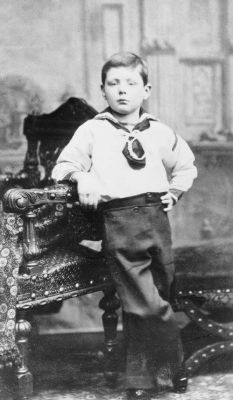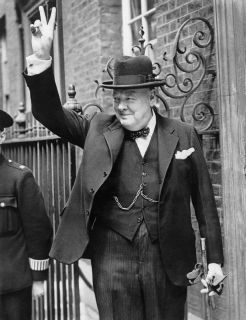Learn to Draw Winston Churchill
Children can learn to draw their own picture of Britain most famous prime minister, Sir Winston Churchill. Just follow along with our step by step instructions.
&npsp;
Winston Churchill (1874 - 1965) is regarded as one of the great leaders of the 20th Century. He was prime minister of Britain twice, the first time leading the country through the turbulent years of the Second World War. We have a short history of his life below, as well as a selection of worksheets and printable activities to use in the classroom.
Churchill's childhood:
Winston Churchill was the son of Lord Randolph Churchill, a politician and wealthy artistocrat, and Jennie, an American. He had a traditional, privileged upbringing, being raised by a nanny (of whom he was very fond) with his younger brother. He was sent away to the first of three boarding schools at 7 years old, including Harrow School from age 13. Although he loved reading, poetry and history, and was good at fencing, he struggled at school because he had bad handwriting and kept losing his books! But he managed to pass his exams.

Winston Churchill aged 7
Churchill's early career:
As a young man, Winston went to Sandhurst, the Army college, and then joined the British cavalry. He travelled to America and Cuba, India and Africa, and sent stories back to newspapers in Britain about his adventures.
When he went to South Africa to report on the Boer War he was captured and became a Prisoner of War. He escaped from prison by climbing out of a window and riding hidden on a train 300 miles to be rescued. As a result he became a celebrity for a while in Britain!
Churchill as MP:
In 1900 Winston Churchill became a Member of Parliament. He held a number of different roles and his career path was bumpy. In 1911 he was made First Lord of the Admiralty, which put him in charge of the Royal Navy, but in 1915, during the First World War, he made some terrible errors when planning an attack on Turkey (the Battle of Gallipoli) and as a result many British, Australian and New Zealand soldiers died. He resigned and went to fight in France until 1917, when he became an MP again. From 1924-1929 he was Chancellor of the Exchequer, but was not a success.
World War II:
When Britain declared war on Germany and World War II began, Churchill was again made First Lord of the Admiralty and invited to join the War Cabinet. In May 1940 he was made prime minister.
Churchill was an inspirational war leader, keeping spirits up with his motivational radio speeches, personal visits to bomb sites and factories, and his "V for Victory" sign. He is also credited with forming strong alliances with the Soviet Union and the United States. Together they won the war in Europe by May 1945.

V for Victory
After the war:
After the war, the Conservative Party was ousted from power and Churchill was no longer Prime Minister. In 1951 the Conservatives won the election and Churchill became prime minister again, serving until 1955. During this second term he was also knighted, becoming Sir Winston Churchill, and awarded the Nobel Prize for Literature for his history books.
Later life:
Sir Winston Churchill remained an MP until 1964. He died on 24th January 1965 and was given a state funeral, watched by 350 million people on television. 112 nations sent representatives and many thousands of people lined the streets in remembrance.
Winston Churchill wrote extensively and is very quotatable - and many of his quotations are particulary suitable for the classroom. Here are of my favourites (some also available as posters below):
Children can learn to draw their own picture of Britain most famous prime minister, Sir Winston Churchill. Just follow along with our step by step instructions.
This colouring page of Sir Winston Churchill picks out some of his most memorable features for younger children - his overcoat, hat and cigar!
Colour in this picture of Sir Winston Churchill, based on a very well-known photo of this British leader and prime minister.
Choose from two designs of our notebooking page for Sir Winston Churchill: the first with space for your child to draw or stick something on, and the second lined throughout.
Here's a slightly different colouirng page of Winston Churchill, which comes with its own frame! When you've coloured in the picture, cut it out and put it up on display.
This simple poster of Winston Churchill might be fun in an early years classroom. "Winnie" is instantly recognisable with his hat, overcoat and, most importantly, cigar!
Sir Winston Churchill said "Attitude is a little thing that makes a big difference" - and of course attitude is something that is of paramount importance in the classroom, in the home and in daily life.
Here's a poster featuring the Winston Churchill quotation: "Success is not final, failure is not fatal: it is the courage to continue that counts."
Use our fun story paper for writing what you have learned about Sir Winston Churchill. We have lined or handwriting versions - and of course there's a colouring picture, too!
Wnston Churchill spoke to the celebrating crowds below from the Ministry of Health balcony on 8th May 1945. Here are the words of his first address.
Read the text of Winston Churchill's most famous victory speech, read out from the balcony of the Ministry of Health on 8th May 1945, VE Day. He made another shorter address earlier in the day.
Winston Churchill became famous for his V for Victory sign. Here is just one of the photo showing him making it! Perhaps his positivity encouraged the country to keep going during hard times and keep striving for victory.
Find out some fun facts about Winston Churchill and use them to fill in this worksheet - available in colour or black and white.
Here's another format of writing page or notebooking page for your Winston Churchill studies - perfect for writing a short essay about him, or perhaps for copying out some of his best quotes.